A common allele of HLA is associated with asymptomatic SARS-CoV-2 infection
- PMID: 37468623
- PMCID: PMC10396966
- DOI: 10.1038/s41586-023-06331-x
A common allele of HLA is associated with asymptomatic SARS-CoV-2 infection
Abstract
Studies have demonstrated that at least 20% of individuals infected with SARS-CoV-2 remain asymptomatic1-4. Although most global efforts have focused on severe illness in COVID-19, examining asymptomatic infection provides a unique opportunity to consider early immunological features that promote rapid viral clearance. Here, postulating that variation in the human leukocyte antigen (HLA) loci may underly processes mediating asymptomatic infection, we enrolled 29,947 individuals, for whom high-resolution HLA genotyping data were available, in a smartphone-based study designed to track COVID-19 symptoms and outcomes. Our discovery cohort (n = 1,428) comprised unvaccinated individuals who reported a positive test result for SARS-CoV-2. We tested for association of five HLA loci with disease course and identified a strong association between HLA-B*15:01 and asymptomatic infection, observed in two independent cohorts. Suggesting that this genetic association is due to pre-existing T cell immunity, we show that T cells from pre-pandemic samples from individuals carrying HLA-B*15:01 were reactive to the immunodominant SARS-CoV-2 S-derived peptide NQKLIANQF. The majority of the reactive T cells displayed a memory phenotype, were highly polyfunctional and were cross-reactive to a peptide derived from seasonal coronaviruses. The crystal structure of HLA-B*15:01-peptide complexes demonstrates that the peptides NQKLIANQF and NQKLIANAF (from OC43-CoV and HKU1-CoV) share a similar ability to be stabilized and presented by HLA-B*15:01. Finally, we show that the structural similarity of the peptides underpins T cell cross-reactivity of high-affinity public T cell receptors, providing the molecular basis for HLA-B*15:01-mediated pre-existing immunity.
© 2023. The Author(s).
Conflict of interest statement
The authors declare no competing interests.
Figures

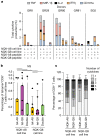






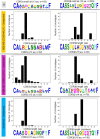
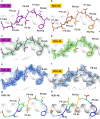
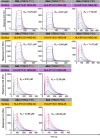
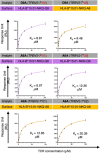
Update of
-
A common allele of HLA mediates asymptomatic SARS-CoV-2 infection.medRxiv [Preprint]. 2022 Oct 12:2021.05.13.21257065. doi: 10.1101/2021.05.13.21257065. medRxiv. 2022. Update in: Nature. 2023 Aug;620(7972):128-136. doi: 10.1038/s41586-023-06331-x. PMID: 34031661 Free PMC article. Updated. Preprint.
Similar articles
-
A common allele of HLA mediates asymptomatic SARS-CoV-2 infection.medRxiv [Preprint]. 2022 Oct 12:2021.05.13.21257065. doi: 10.1101/2021.05.13.21257065. medRxiv. 2022. Update in: Nature. 2023 Aug;620(7972):128-136. doi: 10.1038/s41586-023-06331-x. PMID: 34031661 Free PMC article. Updated. Preprint.
-
Rapid, point-of-care antigen tests for diagnosis of SARS-CoV-2 infection.Cochrane Database Syst Rev. 2022 Jul 22;7(7):CD013705. doi: 10.1002/14651858.CD013705.pub3. Cochrane Database Syst Rev. 2022. PMID: 35866452 Free PMC article.
-
Antibody tests for identification of current and past infection with SARS-CoV-2.Cochrane Database Syst Rev. 2022 Nov 17;11(11):CD013652. doi: 10.1002/14651858.CD013652.pub2. Cochrane Database Syst Rev. 2022. PMID: 36394900 Free PMC article.
-
A pan-beta-coronavirus vaccine bearing conserved and asymptomatic B- and T-cell epitopes protects against highly pathogenic Delta and highly transmissible Omicron SARS-CoV-2 variants.Hum Vaccin Immunother. 2025 Dec;21(1):2527438. doi: 10.1080/21645515.2025.2527438. Epub 2025 Jul 4. Hum Vaccin Immunother. 2025. PMID: 40613499 Free PMC article.
-
The effect of sample site and collection procedure on identification of SARS-CoV-2 infection.Cochrane Database Syst Rev. 2024 Dec 16;12(12):CD014780. doi: 10.1002/14651858.CD014780. Cochrane Database Syst Rev. 2024. PMID: 39679851 Free PMC article.
Cited by
-
The Eye of the Storm: Investigating the Long-Term Cardiovascular Effects of COVID-19 and Variants.Cells. 2023 Aug 27;12(17):2154. doi: 10.3390/cells12172154. Cells. 2023. PMID: 37681886 Free PMC article. Review.
-
Lack of association between classical HLA genes and asymptomatic SARS-CoV-2 infection.HGG Adv. 2025 Apr 10;6(2):100382. doi: 10.1016/j.xhgg.2024.100382. Epub 2024 Nov 2. HGG Adv. 2025. PMID: 39491366 Free PMC article. No abstract available.
-
Immune modulation: the key to combat SARS-CoV-2 induced myocardial injury.Front Immunol. 2025 May 14;16:1561946. doi: 10.3389/fimmu.2025.1561946. eCollection 2025. Front Immunol. 2025. PMID: 40438117 Free PMC article. Review.
-
Role of ACE1, ACE2, and CCR5-Δ32 Polymorphisms in the Transmission of SARS-CoV-2 to Intimate Contacts.Biology (Basel). 2025 May 22;14(6):587. doi: 10.3390/biology14060587. Biology (Basel). 2025. PMID: 40563839 Free PMC article.
-
The molecular mechanisms of CD8+ T cell responses to SARS-CoV-2 infection mediated by TCR-pMHC interactions.Front Immunol. 2024 Oct 10;15:1468456. doi: 10.3389/fimmu.2024.1468456. eCollection 2024. Front Immunol. 2024. PMID: 39450171 Free PMC article. Review.
References
MeSH terms
Substances
Grants and funding
LinkOut - more resources
Full Text Sources
Other Literature Sources
Medical
Molecular Biology Databases
Research Materials
Miscellaneous

